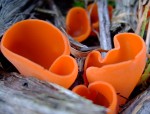 Orange peel fungus belongs to the group called “sac fungi”, Ascomycetes, because they produce their spores is sac-like structures called asci (singular ascus). The asci are produced in cup-like orange fruiting bodies that are flat at first but develop folds with maturity resulting in a look that resembles orange peels, hence the common name. The fungus is common and widespread in Europe and North America where it grows in large colonies in disturbed areas such as roadsides, lawns, and paths from late summer through fall. The cup rests directly on the soil and is .5 to 2 inches tall and ¾ to 4 inches across. The flesh is thin, fragile, brittle and white to orange in color.
Orange peel fungus belongs to the group called “sac fungi”, Ascomycetes, because they produce their spores is sac-like structures called asci (singular ascus). The asci are produced in cup-like orange fruiting bodies that are flat at first but develop folds with maturity resulting in a look that resembles orange peels, hence the common name. The fungus is common and widespread in Europe and North America where it grows in large colonies in disturbed areas such as roadsides, lawns, and paths from late summer through fall. The cup rests directly on the soil and is .5 to 2 inches tall and ¾ to 4 inches across. The flesh is thin, fragile, brittle and white to orange in color.
Although the fungus is considered edible it is not highly regarded for its taste or texture. Its brilliant orange color, however, makes it attractive in various dishes such as a salad. It can be eaten raw unlike its close relatives that contain hemolysins, a chemical that can destroy red blood cells. The cups should be carefully cleaned, and are tough enough to be rinsed in water. They can then be sliced and added to any dish to add color. When collecting orange peel fungus in the wild, seek out expert advice on identification before consuming.
Photo Credit: By Aiwok – Own work, CC BY-SA 3.0, https://commons.wikimedia.org/w/index.php?curid=12209650